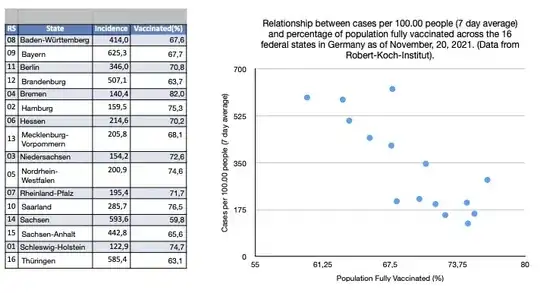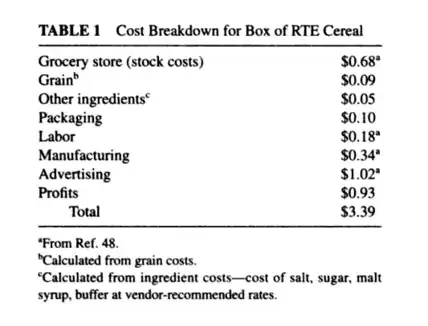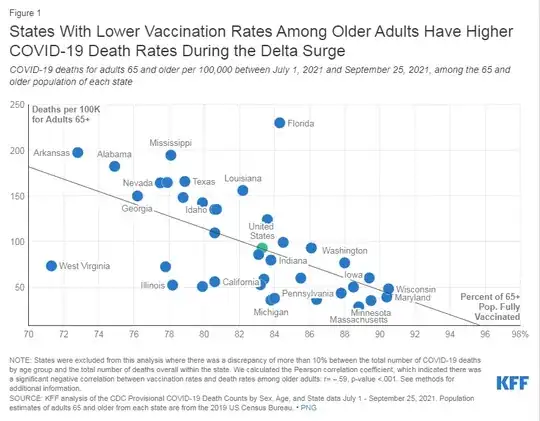(comments turned into an answer as per @Oddthinking's request)
Summary: there are too many other important influencing factors to allow meaningful conclusions about vaccination efficacy from these population level diagrams.
those kind of analyses are useless w.r.t to showing the effects of vaccination on slowing down (or maybe not) a Covid-19 wave?
More direct studies on the effect of vaccination are available at the individual level, e.g. Vaccine effectiveness against infection and onwards transmission of COVID-19: Analysis of Belgian contact tracing data, January-June 2021,
Which reports the following reduction in transmission compared to unvaccinated index patient - unvaccinated high risk contact person:
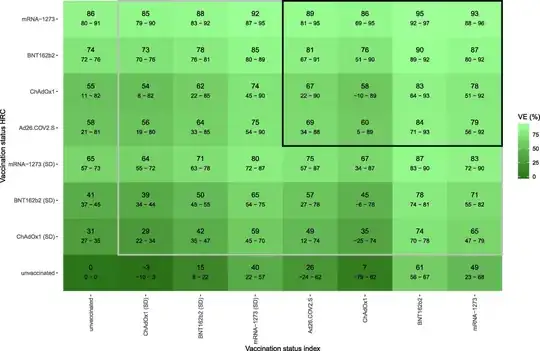
update Wrt delta, the CDC reports vaccine efficacy against infection for Moderna and Pfizer of 53 %**. They do not distinguish probability of being infected vs. infecting, the 53 % is the total reduction (diagonal of the matrix in the Belgian paper).
A UK preprint has similar findings (and time dependency, recommended to read), and similar to the Belgian study, the reduction is largely in lower probability of getting infected if you are vaccinated. A sizeable reduction in the probability of onward transmission is found only with very fresh 2nd vaccination.
I.e. unless you have very high vaccination rates with mRNA (or recovered, which the Belgian paper finds to be comparable), the effect on ongoing transmission in the population will only be a moderate slowing (much less than an order of magnitude, for delta maybe half - that is, delta spreads in vaccinated populations only a little bit slower than the original variant in unvaccinated).
You'd need to distinguish what other factors are controlled for. E.g. a region may be reacting to high levels of vaccination by accepting high incidence since the risk per infection is much lowered. High vaccination rates alone may not be suffient to quench ongoing transmission (consider delta with an R0 of 5. A population 100 % vaccinated with Astra or Johnson (according to the Belgian estimates) would still have to expect R > 1 without further measures to reduce transmission).
OTOH, if regions have largely similar measures in place, higher vaccination rates would be expected to slow down infections more.
Further considerations:
Percentage vaccinated may be a rather incomplete picture without knowing the percentage of the population in question which is immune via recovery but without additional vaccination.
- In Germany, recovered means "had a positive PCR test > 1 and < 6 months ago. Regardless of e.g. antibody titer. Which means that right now in Nov 21, we have few "officially" recovered since the last winter and spring waves are outside the 6 month window by now. From an epidemiological perspective, however, their immunity is not suddenly switched off after 6 months (the study linked above in J.Vaccine says "There was no significant difference between protection by full-dose vaccination and previous infection.", previous infection being defined as positive antigen test > 3 months ago).
Also, the standing committee on vacciation's recommendation treats those with positive specific antibody titer even without knowing when the infection occured (i.e. recovered, but dark figure) as equal to the officially recovered.
I'm not aware of data saying how many of the recovered from any of the previous waves are now vaccinated and how many are not.
- Relevant for this question: news report about GPs sending not everyone of the same household for to get their own PCR test The region (Erzgebirge/Saxony) discussed is one that is in the news now due to very low percentage of vaccinated and high infection rates.
My take on the situation: I expect they have a higher dark figure of people immune due to previous infection than other regions. Not to the extent that (nearly) everyone is immune there now (until summer, close to 10 % of Saxons have officially had Corona, even with dark figure of 100 - 200 % this cannot nearly close the gap in immunity), but it may very well be sufficient to shift them (the lowest vaccination rate data point) sufficiently into the center of the % vaccinated range to substantially reduce the observed correlation.
For the other extreme, Bremen, there is some discussion how many of the vaccinations were given to commuters from Niedersachsen [they vaccinated whoever came - whereas e.g. in Hesse one had to go to the vaccination center of one's home Kreis (county).] - which may shift them also a bit further into the "big crowd".
Are the case rates notification rates (like the official numbers for Germany) that have a huge dependendy on rules for testing (e.g. vaccinated being exempt from regular testing) or incidences including dark figure estimates?
Also, "new cases in the last 7 days" (obviously) would undergo important changes over the course of a wave. And unless these happen synchronousĺy (on a time scale with 1 week averages) in all Länder - which would be a ridiculous assumption - this will easily mix up the diagram.
Had you done your diagram for Germany end of August/beginning of September, Saxony and Thuringia would also have shown up at the low vaccination rate end of the diagram - but with low case rates instead of high case rates - whereas Bremen would have been at high vaccination high incidence (vs. high vaccination low incidence now [missing in OP's diagram]):
I found a table from Sept. 8th in a newspaper
| Bundesland |
Inzidenz |
Impfquote |
| Baden-Württemberg |
91.0 |
60.4 |
| Bayern |
77.5 |
59.5 |
| Berlin |
81.0 |
61.3 |
| Bremen |
117.6 |
71.4 |
| Brandenburg |
37.5 |
55.8 |
| Hamburg |
78.9 |
65.1 |
| Hessen |
113.6 |
60.6 |
| Mecklenburg-Vorpommern |
36.4 |
60.2 |
| Niedersachsen |
71.6 |
63.4 |
| Nordrhein-Westfalen |
109.4 |
64.2 |
| Rheinland-Pfalz |
103.0 |
61.6 |
| Saarland |
89.2 |
67.7 |
| Sachsen |
32.2 |
52.4 |
| Sachsen-Anhalt |
25.3 |
58.1 |
| Schleswig-Holstein |
49.1 |
65.7 |
| Thüringen |
38.3 |
56.2 |
The corresponding diagram is:
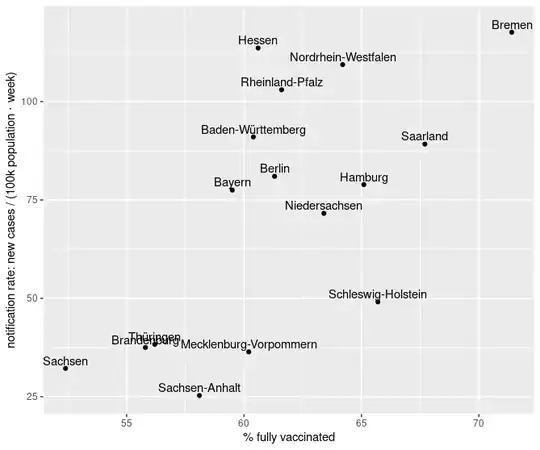
Putting this together with OP's table (which I can not(!) confirm looking at the recent historical data available at the RKI):
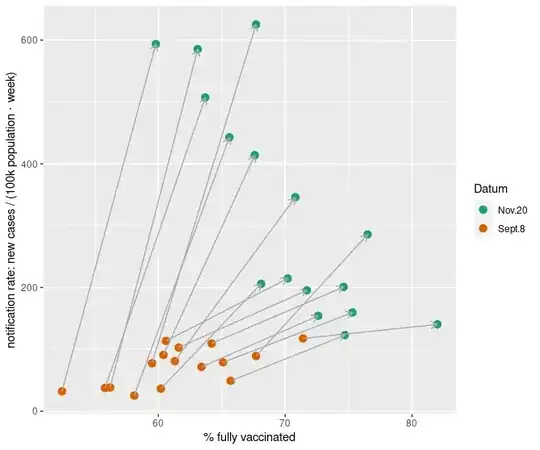
Seeing all this, I don't think "no relationship found" across a diverse set of populations should be that surprising. Nor should it be surprising that looking at a smallish subset of regions at one point in time can exhibit a pattern in one direction or the other.
Oh, and careful with significant: significance doesn't imply that the effect size is sufficient to be of practical importance. @BenBolker's point estimate of 1.4 additional cases /(100k population ⋅ week ⋅ additional % vaccinated) i.e. about 20 cases / (100k population ⋅ week) difference over the ≈ difference of 15 %-points in fraction vaccinated in your diagram would be barely visible as an increase.
The data from J.Vaccine. means that in terms of transmission the effect of vaccination is in the same order of magnitude as other measures like testing (and immediately quarantining if positive), proper vs. improper wearing of medical masks, meeting outdoors instead of indoors etc.
From a statistical point of view, that's about the most difficult situation we can find ourselves in: several influencing factors that have effects in the same order or magnitude. Such a situation can only be sorted out by very carefully designed studies, not by an overview glance at raw data. The latter would only be possible if all but one dominating factor could be dropped.

